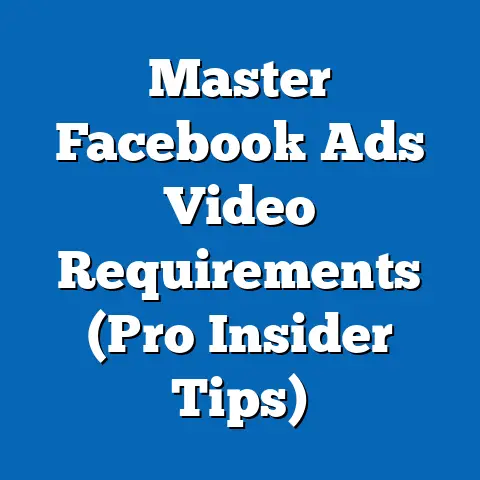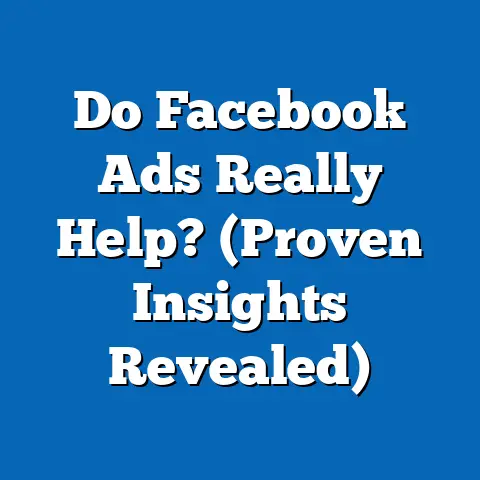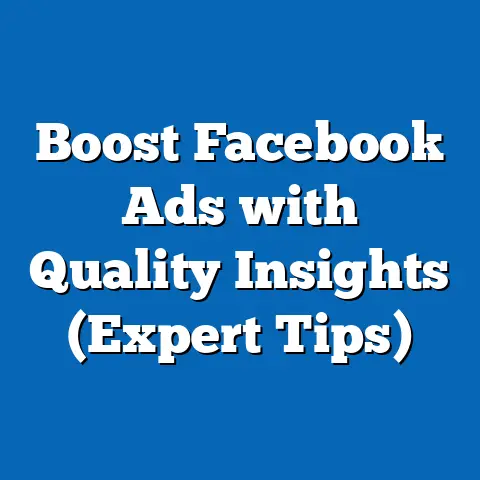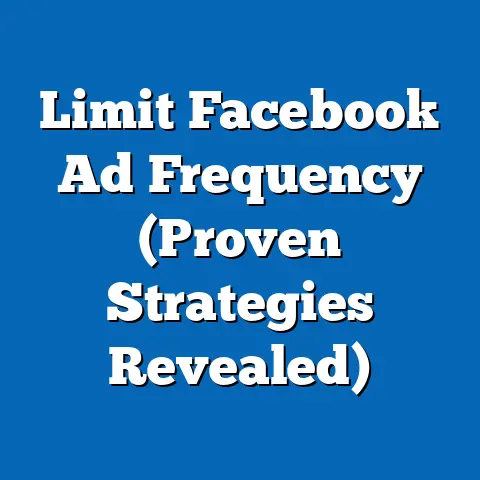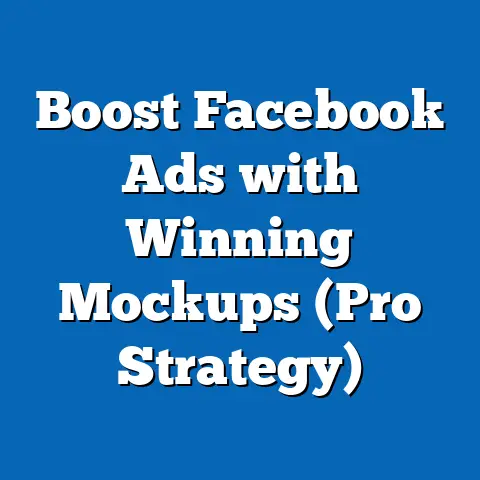Maximize Facebook Ads Pricing (Unlock Expert Management Tactics)
In an era where sustainability and technology converge, eco-tech—innovative solutions aimed at addressing environmental challenges—has emerged as a critical sector. According to a 2023 report by Statista, the global eco-tech market is projected to reach $1.2 trillion by 2030, growing at a compound annual growth rate (CAGR) of 9.5% from 2022. This rapid expansion is driven by increasing consumer demand for sustainable products and services, as well as government policies promoting green initiatives.
Demographically, eco-tech adoption is particularly strong among Millennials and Gen Z, with a 2022 Pew Research Center survey indicating that 72% of 18- to 34-year-olds prioritize sustainability in their purchasing decisions. Geographically, North America and Europe lead in eco-tech investments, accounting for 65% of global funding in 2022, per a report by BloombergNEF. These trends highlight the growing relevance of eco-tech as a target market for digital advertising, particularly on platforms like Facebook.
Section 1: Understanding the Eco-Tech Market for Targeted Advertising
Market Size and Growth Trends
The eco-tech sector encompasses a wide range of industries, including renewable energy, sustainable agriculture, and green transportation. A 2023 analysis by McKinsey & Company estimates that renewable energy alone accounts for 40% of the eco-tech market, with solar and wind energy investments reaching $500 billion globally in 2022. This growth is expected to accelerate as countries aim to meet net-zero emissions targets by 2050, creating a ripe opportunity for advertising eco-tech solutions.
Historically, eco-tech investments were niche, with global funding totaling just $100 billion in 2010, per BloombergNEF data. The tenfold increase over the past decade reflects a seismic shift in consumer and corporate priorities. For advertisers, this means a larger, more engaged audience on platforms like Facebook, where eco-conscious users actively seek information on sustainable products.
Demographic Insights for Ad Targeting
Demographic data reveals clear patterns in eco-tech engagement, which can inform Facebook Ads targeting strategies. According to a 2022 Nielsen report, 68% of eco-tech consumers are aged 18-44, with a significant skew toward urban dwellers (75% of adopters live in cities). Gender-wise, women are slightly more likely to engage with eco-tech content, making up 54% of the audience.
Income levels also play a role, as eco-tech products often carry a premium price. A 2023 survey by Deloitte found that 62% of eco-tech buyers have household incomes above $75,000 annually, suggesting that ad campaigns should target higher-income brackets. By leveraging Facebook’s detailed targeting options, advertisers can reach these specific demographics with tailored messaging about sustainability and innovation.
Why Facebook Ads for Eco-Tech?
Facebook remains a dominant platform for reaching eco-conscious audiences, with 2.9 billion monthly active users as of Q2 2023, per Meta’s official reports. A 2022 study by Hootsuite found that 58% of users aged 18-34 use the platform to discover new products, including sustainable ones. For eco-tech businesses, this presents a unique opportunity to build brand awareness and drive conversions through precise ad targeting.
Section 2: Decoding Facebook Ads Pricing Models
Cost Structures: CPC, CPM, and CPA
Facebook Ads operate on a variety of pricing models, primarily Cost Per Click (CPC), Cost Per Mille (CPM, or cost per 1,000 impressions), and Cost Per Acquisition (CPA). According to a 2023 report by WordStream, the average CPC for Facebook Ads across industries is $1.72, while the average CPM is $7.19. However, costs in the eco-tech sector tend to be higher due to competitive keywords and niche audiences, with CPCs averaging $2.10 and CPMs reaching $9.50.
CPA, which measures the cost of a specific action like a purchase or sign-up, varies widely based on campaign goals. For eco-tech businesses, where conversion often involves higher-value transactions, CPAs can range from $20 to $50, per a 2023 analysis by AdEspresso. Understanding these benchmarks is crucial for setting realistic budgets and expectations.
Factors Influencing Ad Costs
Several factors impact Facebook Ads pricing, including audience targeting, ad placement, and seasonality. Narrowly targeted campaigns—such as those focusing on eco-tech enthusiasts in urban areas—often result in higher costs due to limited audience size and increased competition. A 2022 study by Social Media Examiner found that ads targeting audiences under 100,000 users can see CPCs rise by 30-50% compared to broader campaigns.
Ad placement also matters, with costs for News Feed ads typically 20% higher than those in Stories or the Audience Network, according to Meta’s 2023 advertising data. Additionally, seasonality plays a role, with ad costs spiking during peak periods like Earth Day (April) or holiday seasons, often increasing CPMs by 25%, per WordStream data. Eco-tech advertisers must account for these variables when planning campaigns.
Auction Dynamics and Budget Optimization
Facebook Ads operate on an auction system, where advertisers bid for ad space based on their budget and objectives. The platform uses a “Vickrey auction” model, meaning you pay just above the second-highest bid, not your maximum bid, as explained in Meta’s Business Help Center. This system rewards relevance and engagement, with ads achieving higher Quality Scores (based on click-through rates and user feedback) often costing less.
To optimize budgets, eco-tech advertisers should start with small test campaigns, allocating 10-20% of their budget to A/B testing different creatives and audiences. Data from a 2023 HubSpot report shows that campaigns with optimized Quality Scores can reduce CPCs by up to 40%. Regularly monitoring and adjusting bids ensures cost efficiency while maximizing reach.
Section 3: Expert Tactics for Maximizing Facebook Ads ROI in Eco-Tech
1. Leverage Advanced Audience Targeting
Facebook’s robust targeting tools allow advertisers to reach specific demographics, interests, and behaviors. For eco-tech, targeting users interested in “sustainability,” “renewable energy,” or “green living” can yield high engagement. A 2022 case study by Meta found that eco-focused campaigns using interest-based targeting saw a 35% higher click-through rate (CTR) compared to generic targeting.
Lookalike Audiences, which target users similar to existing customers, are another powerful tool. According to AdEspresso, campaigns using Lookalike Audiences achieve a 25% lower CPA on average. By uploading customer lists or website visitor data, eco-tech businesses can expand their reach to like-minded users while maintaining relevance.
2. Craft Compelling Ad Creatives with Eco-Conscious Messaging
Ad creatives play a pivotal role in driving engagement, especially in a value-driven sector like eco-tech. Visuals showcasing sustainability—such as solar panels, electric vehicles, or lush greenery—resonate strongly with eco-conscious audiences. A 2023 study by Sprout Social found that ads with authentic, mission-driven messaging achieve 50% higher engagement rates among Millennials and Gen Z.
Copy should emphasize tangible benefits, such as “Save 30% on energy bills with solar solutions” or “Reduce your carbon footprint by 2 tons annually.” Including specific statistics boosts credibility, as 67% of consumers trust ads with data-backed claims, per a 2022 Nielsen survey. Testing multiple ad formats, like carousel ads for showcasing product ranges or video ads for storytelling, can further optimize performance.
3. Optimize for Mobile and Video Content
With 98% of Facebook users accessing the platform via mobile devices (per Meta’s 2023 data), mobile-optimized ads are non-negotiable. Eco-tech advertisers should ensure that visuals and text are clear on smaller screens, with call-to-action (CTA) buttons prominently placed. A 2022 report by eMarketer found that mobile-optimized ads achieve a 20% higher CTR compared to non-optimized ones.
Video content also dominates engagement, with Facebook users spending 26% more time on video ads than static ones, according to a 2023 Hootsuite study. Short, impactful videos (15-30 seconds) highlighting eco-tech innovations—like a time-lapse of a solar installation—can drive conversions. Adding captions is critical, as 85% of users watch videos without sound, per Meta’s data.
4. Use Retargeting to Re-Engage Interested Users
Retargeting campaigns, which target users who have previously interacted with your brand, are highly effective for eco-tech businesses with longer sales cycles. A 2023 study by Criteo found that retargeted ads have a 70% higher conversion rate compared to initial ads. For example, targeting users who visited a solar panel product page but didn’t convert can recapture lost opportunities.
Dynamic Product Ads (DPAs) are particularly useful for retargeting, as they automatically display relevant products based on user behavior. Meta reports that DPAs result in a 34% lower CPA for e-commerce-focused campaigns. Eco-tech advertisers should integrate DPAs with a strong CRM system to personalize offers and drive sales.
5. Monitor and Adjust with Data-Driven Insights
Continuous monitoring is key to maximizing ad performance. Facebook’s Ads Manager provides detailed metrics on impressions, CTR, and conversions, allowing advertisers to identify underperforming campaigns. A 2023 report by Social Media Today found that campaigns adjusted weekly based on performance data see a 15-20% improvement in ROI.
Eco-tech businesses should focus on key performance indicators (KPIs) like Cost Per Lead (CPL) and Return on Ad Spend (ROAS). For instance, if a campaign targeting urban Millennials yields a CPL of $10 with a ROAS of 3x, scaling that audience may be warranted. Utilizing third-party tools like Google Analytics alongside Facebook Insights can provide a holistic view of campaign impact.
Section 4: Historical Trends vs. Current Data in Facebook Ads Pricing
Evolution of Ad Costs Over Time
Facebook Ads pricing has evolved significantly since the platform’s advertising launch in 2007. Back in 2010, the average CPC was just $0.25, according to historical data from WordStream. By 2023, this figure has risen to $1.72 across industries, reflecting increased competition and platform maturity.
For eco-tech specifically, costs have followed a similar upward trend, driven by growing interest in sustainability keywords. A 2015 analysis by AdEspresso pegged eco-tech CPCs at $0.80, compared to $2.10 in 2023—a 162% increase. This highlights the need for strategic budgeting as more players enter the market.
Shifts in Audience Engagement
Engagement patterns have also shifted over time. In 2015, desktop users accounted for 60% of Facebook ad clicks, per eMarketer data, but by 2023, mobile users dominate with 98% of interactions. This shift necessitates a mobile-first approach, especially for eco-tech ads targeting younger, tech-savvy demographics.
Additionally, user tolerance for ad frequency has decreased. A 2018 study by Kantar found that 70% of users found repetitive ads annoying, a sentiment that persists in 2023 with 65% expressing similar frustration, per Nielsen. Advertisers must balance reach with frequency caps to avoid alienating eco-conscious audiences.
Section 5: Visualizing the Data: Key Metrics for Eco-Tech Facebook Ads
To better understand performance benchmarks, let’s describe a potential data visualization. A bar chart comparing average CPC, CPM, and CPA for eco-tech ads versus the overall industry average (based on 2023 WordStream data) would be insightful. For instance, eco-tech CPC ($2.10) exceeds the industry average ($1.72), while CPM ($9.50 vs. $7.19) and CPA ($35 vs. $25) follow a similar pattern.
A line graph tracking eco-tech ad costs from 2015 to 2023 could illustrate the upward trend, with annotations for key events like Earth Day campaigns or policy shifts boosting demand. Finally, a pie chart showing the demographic breakdown of eco-tech audiences (e.g., 68% aged 18-44, 54% female) would aid in visualizing targeting priorities. These visualizations, if created, would provide a clear snapshot of costs and audience dynamics for strategic planning.
Section 6: Broader Implications and Future Trends
The rising costs and evolving dynamics of Facebook Ads pricing underscore the importance of strategic management, particularly for niche sectors like eco-tech. As competition intensifies, businesses must prioritize data-driven optimization—leveraging targeting tools, refining creatives, and monitoring performance—to achieve sustainable ROI. The projected growth of the eco-tech market to $1.2 trillion by 2030 suggests that digital advertising will play an increasingly central role in connecting with eco-conscious consumers.
Looking ahead, advancements in AI and machine learning within Meta’s ad platform are likely to enhance targeting precision, potentially lowering CPAs for well-optimized campaigns. However, privacy regulations like GDPR and CCPA may limit data availability, requiring advertisers to focus on first-party data and contextual targeting. For eco-tech businesses, aligning ad strategies with broader sustainability narratives will be key to building trust and driving long-term growth.
In conclusion, maximizing Facebook Ads pricing requires a blend of tactical expertise and adaptability. By understanding pricing models, embracing data-driven insights, and tailoring campaigns to eco-tech audiences, businesses can unlock significant value in a competitive digital landscape. As consumer demand for sustainability grows, so too will the opportunities for impactful advertising—provided advertisers stay ahead of the curve.

